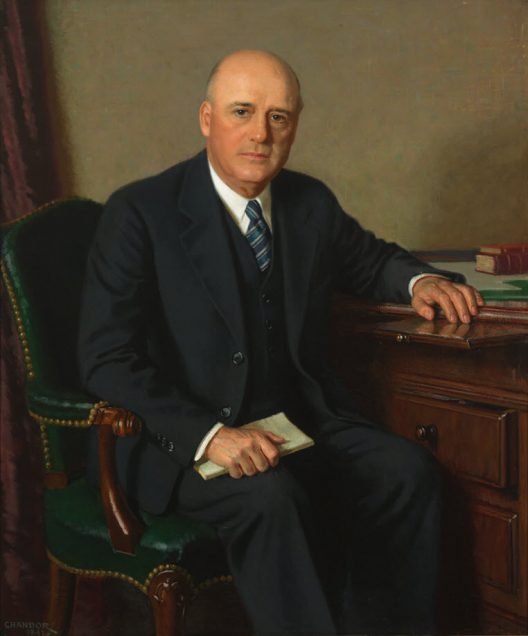Category: Legislative Operations
A Legal Tug-of-War between the Massachusetts State Auditor and the Legislature
The Commonwealth of Massachusetts finds itself at a constitutional crossroads as the legal tug-of-war unfolds between the State Auditor and the Legislature. In August 2023, the Massachusetts State Auditor, Diana DiZoglio, sent a letter to Attorney General Andrea Campbell stating she was conducting an audit of both the Massachusetts Senate and House of Representatives (the Legislature). This audit would include “budgetary, hiring, spending, and procurement information, information regarding active and pending legislation, the process for appointing committees, the adoption and suspension of legislative rules, and the policies and procedures of the Legislature.” However, Campbell responded that the auditor cannot unilaterally probe the Legislature without its consent. In this case, both Ronald Mariano, Speaker of the Massachusetts House of Representatives, and Karen Spilka President of the Massachusetts Senate rejected DiZoglio’s audit. They reasoned that the financial documents of the legislature are made public and the other information DiZoglio is requesting violates the separation of powers. This conflict is not new but rather a historical tug-of-war between the branches of government and the delegation of powers. This debate requires a comprehensive analysis of statutory powers, historical positions, and constitutional considerations.
 DiZoglio is asserting her power to conduct this audit under the State Auditor’s enabling statute, M.G.L. c. 11 § 12. Section 12 directs the State Auditor to audit “accounts, programs, activities and functions directly related to the aforementioned accounts of all departments, offices, commissions, institutions and activities of the commonwealth, including those of districts and authorities created by the general court and including those of the income tax division of the department of revenue.” The language that Campbell focused on was the meaning of “departments” and whether the Legislature was intended to be included in that term. Campbell scrutinized various cases and the texts of other statutes using this term concluding that “department” is more restricted than it appears. From a historical perspective, the term “department” appeared in the text of the statute in 1920 at the same time the Massachusetts’s general laws were enacted and when the Executive Branch was reorganized into “departments.” Upholding the precedent of her predecessors, Campbell adopted the view that “the word ‘department’ in statutes such as these should in general encompass only executive branch departments.”
DiZoglio is asserting her power to conduct this audit under the State Auditor’s enabling statute, M.G.L. c. 11 § 12. Section 12 directs the State Auditor to audit “accounts, programs, activities and functions directly related to the aforementioned accounts of all departments, offices, commissions, institutions and activities of the commonwealth, including those of districts and authorities created by the general court and including those of the income tax division of the department of revenue.” The language that Campbell focused on was the meaning of “departments” and whether the Legislature was intended to be included in that term. Campbell scrutinized various cases and the texts of other statutes using this term concluding that “department” is more restricted than it appears. From a historical perspective, the term “department” appeared in the text of the statute in 1920 at the same time the Massachusetts’s general laws were enacted and when the Executive Branch was reorganized into “departments.” Upholding the precedent of her predecessors, Campbell adopted the view that “the word ‘department’ in statutes such as these should in general encompass only executive branch departments.”
DiZoglio contends that the Auditor’s Office has a precedent for auditing the Legislature, citing historical reports conducted on various agencies. The Auditor’s Office originally was charged with collecting annual reports on various government agencies that was eventually transferred to the Office of the Comptroller when that office was created 1922. The pre-1923 reports provided a broad overview of the financial information specifically detailing how the Legislature could reduce its expenditures. Campbell pointed out that the information that the Auditor is currently requesting goes beyond the limited scope and the functions the Auditor currently possesses. The reports from 1923-1971 were once again narrowly construed to certain entities “under the purview of the Legislature,” but not the Legislature as whole as DiZoglio is attempting to do now. From 1972-1990, the Auditor conducted audits of three specific legislative entities and reporting on their expenditures, appropriations, and other miscellaneous income. In 1978, the Senate stopped complying with the Auditor’s audits after the Massachusetts Supreme Judicial Court decided Westinghouse Broadcasting Co. v. Sergeant-at-Arms of General Court (Mass. 1978). In Westinghouse, the Court held that “the records generated by the Legislature could be made available to outsiders only at the discretion of the House and Senate leadership.” The Senate cited this holding to restrict the Auditor’s access to certain records. From 1990 until 2023, the Auditor conducted three narrow audits of legislative operations: addressing overpayments to a court officer in 1992, IT-related controls by the Sergeant-at-Arms in 2002, and Legislative Information Services in 2006. In contrast, the Auditor’s proposed broad audit will scrutinize core legislative powers rather than specific issues or entities.
 The enforcement of orders for document production against the Legislature raises serious constitutional questions related to the separation of powers. These concerns were raised by former State Auditors, Suzanne Bump and A. Joseph DeNucci. If the Auditor moves forward with the audit, it would require the Superior Court to enforce those orders against the Legislature’s consent. As provided by the Massachusetts Constitution, the legislative branch has the authority to establish its own rules and proceedings. Thus, if the Judiciary enforced the audit against the Legislature, it would be interfering directly with the Legislature’s core functions. Although Attorney General Campbell did not go so far as to define the extent of the constitutional limitations, it did acknowledge the potential for such an issue to arise.
The enforcement of orders for document production against the Legislature raises serious constitutional questions related to the separation of powers. These concerns were raised by former State Auditors, Suzanne Bump and A. Joseph DeNucci. If the Auditor moves forward with the audit, it would require the Superior Court to enforce those orders against the Legislature’s consent. As provided by the Massachusetts Constitution, the legislative branch has the authority to establish its own rules and proceedings. Thus, if the Judiciary enforced the audit against the Legislature, it would be interfering directly with the Legislature’s core functions. Although Attorney General Campbell did not go so far as to define the extent of the constitutional limitations, it did acknowledge the potential for such an issue to arise.
The Attorney General’s Office holds firm that the Auditor’s current authority does not extend to auditing the Legislature without consent. In response, the Auditor sought to ask the public whether she has the authority to audit the legislature through a question on 2024 ballot. DiZoglio’s proposal received over 100,000 signatures and is on track to be included on the 2024 state-wide ballot. First, however, the Legislature reviews the proposal, with the Judiciary Committee holding a tense hearing in March 2024. DiZoglio testified,
“Our office provides a resource to this commonwealth. Contrary to the narrative that some legislators and their supporters have been spinning, [my] office is not the FBI. We do not go in and raid people’s offices. We do not have the ability to toss desks. Our staff conducts performance audits. Audits. The amount of opposition to audits from this body is deeply, deeply disturbing and concerning on so many levels.”
However, Jeremy Paul, a law professor at Northeastern University, testified that the courts may invalidate the new law if the voters approve it in November.
“I submit that the power to audit may well turn out to be the power to destroy. It’s one thing to push for greater transparency in legislative operations so that the public is given more information. It’s entirely another to give an elected official inside the elected branch discretion to decide which legislators can be called to account for what reasons and when.”
Thus, the saga continues, serving as a constant reminder of the delicate balance that needs to be struck within our democratic system between responsibility, transparency, and the preservation of constitutional principles.
 Abigail Rooney West anticipates graduating from Boston University School of Law in May 2024.
Abigail Rooney West anticipates graduating from Boston University School of Law in May 2024.
Chaos
I bought a painting!
I am not a major collector by any means, but I could not pass this one up:
The painting, entitled "Chaos," is by Austin Texas based artist Laura Atlas Kravitz from Lollies Follies Studio. A lawyer, Laura works in government relations for an education organization. She started painting as a stress relief and a way to bring the community together. One of Laura's ongoing themes is the Texas State Capitol and how she sees it depending on the day, time of year, and perhaps most importantly, what is going on at the time.
The Texas State Capitol was constructed between 1882 and 1888 and has been a National Historic Landmark in 1986. The Capitol is located on a hilltop overlooking downtown Austin and is an example of Italian Renaissance Revival style. Although it is taller  than the US Capitol, it is only the sixth tallest state capitol, so there is at least one thing that isn’t bigger in Texas! Then again, the Capitol has almost 400 rooms and at 360,000 square feet of floor space, it is the largest state capitol in the United States.
than the US Capitol, it is only the sixth tallest state capitol, so there is at least one thing that isn’t bigger in Texas! Then again, the Capitol has almost 400 rooms and at 360,000 square feet of floor space, it is the largest state capitol in the United States.
The building has a pink hue because it is constructed of local sunset red granite. When the building was dedicated there was a weeklong celebration that included cattle roping, baseball games, singing groups, and fireworks. Some attendees purchased pieces of red granite as souvenirs.
The Capitol is topped with the statue Goddess of Liberty, a sculpture by Elijah E. Myers. In 1986, the original sculpture was replaced by a replica and the restored original is now in the The Bullock Texas State History Museum.
So why did I like this painting so much?
Anyone who has worked in Congress or a legislature knows the emotion that this painting evokes. Most of Laura’s other paintings of the Capitol (available on Etsy) are light, some with many colors. Here the Capitol is surrounded by darkness. This, however, is not the darkness of a clear Texas night where the Goddess of Liberty generously adds a star to the firmament. This is a gloomy, yet swirling, darkness that at once uproots the Capitol from its Austin hilltop but also weighs the Capitol down. The darkness churns, not from winds or storm, but from uncertainty.
Laura tells me she painted “Chaos” a few days into the Legislature’s Second Special Session --a very chaotic time. A group of House Democrats had decamped to Washington DC in an attempt to stop what they saw as an odious bill that would have restricted voting rights. In return, Governor Greg Abbot, in a cruel-yet predictable-move, vetoed funding for the legislature and its 2,100 employees. That is fine for the legislators themselves, who are paid very little for their service and stand for election for reasons other than financial gain. It was obnoxious, however, to threaten the legislative staff—the people who keep the Capitol clean, the ones who answer telephone calls from constituents, the legal and policy staff who draft and redraft the bills to be debated. This year, they were working special session after special session. Staff work long unpredictable hours with tremendous stress. Further, legislative staff, especially lawyers, are typically paid far less than what they could make in other jobs. In large part, they do their job out of a sense of public service. To threaten the staff and their families with no pay was unconscionable.
Some will blame the missing Democrats for the chaos. I generally believe that when someone is honored by their constituents to represent their community they have an obligation to be there. If you are going to break quorum, however, it should be over something vitally important—like protecting the voting rights of the powerless and underrepresented. The Republicans pushing these voting rules might point out that they control the Legislature and under our system the majority rules. True. Still, in a Constitutional system, the will of the majority is tempered--and sometimes thwarted--by the God-given rights of the minority. Efforts to protect someone's ability to vote, which is referred to as a right in the US Constitution no less than five times, is--or should be--an example of when extraordinary measures are required.
I really like that Laura used gold to define the Capitol rather than another color—especially the pink of the actual granite. Gold is not just valuable, but precious. Legislatures, both as an institution and as a concept, are precious as well--even in difficult, chaotic times. People peacefully debating to work out their differences and create policy for the greater good may be the most valuable thing ever devised by society. In this painting the gold is swirling off the building and into the gloom. Unlike red granite, gold is malleable and soft. It is easily molded into something beautiful; but items made of gold can just as easily be scratched, chipped away, or destroyed.
In times of chaos, the legislature can suffer—both in its reputation held by the people outside the building and in the faith and enthusiasm of the people within. Luckily, when the legislative body returns to normal and functions as it should, the precious gold luster can be both restored and augmented—in preparation for the next storm of chaos.
I will end my amateur art analysis by noting that the gloom in Laura's painting is not total--there are spots of light in the dark. Looking at the painting the light spots are amidst splotches that could have been caused by drops of sweat--or tears. Still, hope hides just beyond the chaos. The British poet Alfred Noyes wrote The Road Through Chaos, which begins:
There is one road, one only, to the Light:
A narrow way, but Freedom walks therein;
A straight, firm road through Chaos and old Night,
And all these wandering Jack-o-Lents of Sin.
It is the road of Law, where Pilate stays
To hear, at last, the answer to his cry;
And mighty sages, groping through their maze
Of eager questions, hear a child reply.
I have commissioned Laura for another painting of the Capitol on the theme of “Sine Die” when the session finally, mercifully comes to an end and the legislative business, for better or worse, concludes.
I can’t wait to see what she comes up with.
n.b. All opinions in this article are mine alone and do not reflect those of the artist.
Who Will Save the Africa Parliamentary Knowledge Network? by Elizabeth Bakibinga-Gaswaga
The bright promise that was the Africa Parliamentary Knowledge Network (APKN) is seemingly fading away. This important project, where African parliamentarians and their staff committed to help each other build capacity and share information was making a real difference in the governance of Africa. Sadly, when the United Nation's Department of Economic and Social Advancement (UN/DESA), using funds provided by the government of Italy, stopped supporting the APKN financially a few years ago, the Network not only lost momentum, but seemingly stopped altogether. Just because the Network has been quiet, and perhaps has frayed from lack of use (the Network’s website, APKN.org, is now a Japanese fashion page) does not mean that it is lost. The talented and dedicated people from the various parliaments who made the APKN so promising should take the lead and chart a new course for the Network. This will take participation from across the Continent and should be driven by African voices. This effort will also take money. It is unlikely the UN will be a source-- but perhaps between the APKN members and the partners who have already shown a willingness to support the Network, we can find a new vision and the money to make that vision a reality. For instance, the Commonwealth Parliamentary Association is a potential partner. This conversation could start at the Commonwealth Association of Legislative Counsel (CALC) conference that will take place in Livingstone, Zambia April 1-3, 2019.
 The APKN was established in June 2008 by the international conference “Africa Parliamentary Knowledge Network - Building Together Open and Learning Parliaments in Africa” in Cairo, Egypt. The APKN operated under the authority of the Speakers and Presidents of APKN member assemblies--30 assemblies in all. Representatives of the APKN assemblies met in plenary every two years to approve the reports of activities, the Executive Committee's strategic action plan, and to set new priorities and goals for the next two years. The Network was “hosted" by a variety of Parliaments who took the lead in putting together conferences and led the Executive Committee. The first host was Egypt, before the turmoil and revolution in that country. The next host was South Africa, and finally the Pan-African Parliament took the lead.
The APKN was established in June 2008 by the international conference “Africa Parliamentary Knowledge Network - Building Together Open and Learning Parliaments in Africa” in Cairo, Egypt. The APKN operated under the authority of the Speakers and Presidents of APKN member assemblies--30 assemblies in all. Representatives of the APKN assemblies met in plenary every two years to approve the reports of activities, the Executive Committee's strategic action plan, and to set new priorities and goals for the next two years. The Network was “hosted" by a variety of Parliaments who took the lead in putting together conferences and led the Executive Committee. The first host was Egypt, before the turmoil and revolution in that country. The next host was South Africa, and finally the Pan-African Parliament took the lead.
During its short life, the APKN had a string of successes; thanks in large part to the tireless work of the UN/DESA technical advisors, Flavio Zeni and Dr. Cecilia Matanga. The APKN issued a comprehensive set of legislative drafting guidelines for use across the Continent to allow better informatics sharing while remaining true to best practices in legislative drafting. An assembly of drafters from APKN countries refined and ratified the Guidelines at a 2010 conference in Cape Town South Africa. In 2011, UN/DESA, in conjunction with the APKN issued a handbook on designing legislation for the free use of drafters everywhere.
Perhaps the greatest victory is that earlier this year the legislative platform designed for APKN, Akoma Ntoso V1.0 became the newest Organization for the Advancement of Structured Information Standards (OASIS) Standard— the only OASIS standard with an African name (“linked hearts” in the Akan language of West Africa) to honor those who nurtured and promoted the platform. This platform is used by many institutions around the world — the European Parliament, European Commission, the Italian and Swiss parliaments, and other parliaments in both America and Asia. Still, no African parliament has adopted Akoma Ntoso platform —perhaps because of the missing APKN.
APKN served other important functions: one was simply bringing African legislators and drafters together to meet, talk and exchange ideas at periodic conferences. In addition, the APKN LawClinics had law students at Boston University School of Law drafting legislation with African drafters and law students at African universities for parliaments in Uganda, Zambia, Liberia and the East African Legislative Assembly.
Where do we go now? At a conference in 2011, when participants asked what APKN would do next, Flavio Zeni responded, "You are APKN!" The Network was never meant to be driven by the UN or an outside partner such as a European parliament or American university. African parliamentarians and African drafters must lead the Network and give it vitality.
Should there be a website to share legislative ideas and language like the United States' National Council of State Legislatures? Should the Network train legislative drafters? Should it train new members of parliament? Should it take position on and suggest methods for legislative reform? Should there be an annual conference, and what would be the goals of that conference?
We will send this posting to the various African parliamentary leaders, those who have been active with the APKN in the past, and to the CALC community at large. If anyone who would like to make suggestions, on either a vision for APKN or a source of funding, we will post the ideas on BU Law’s Dome blog webpage. Our hope is that we can bring several potential suggestions to the CALC conference in April for discussion amongst drafters from APKN countries and their allies. Together, we can reinvigorate APKN and support stronger parliaments across Africa.
 Elizabeth Bakibinga-Gaswaga was involved in AKPN as a legislative counsel for the Parliament of Uganda and is an active member of CALC. Elizabeth represented Africa on the CALC Executive Council and later served as CALC's Vice President.
Elizabeth Bakibinga-Gaswaga was involved in AKPN as a legislative counsel for the Parliament of Uganda and is an active member of CALC. Elizabeth represented Africa on the CALC Executive Council and later served as CALC's Vice President.
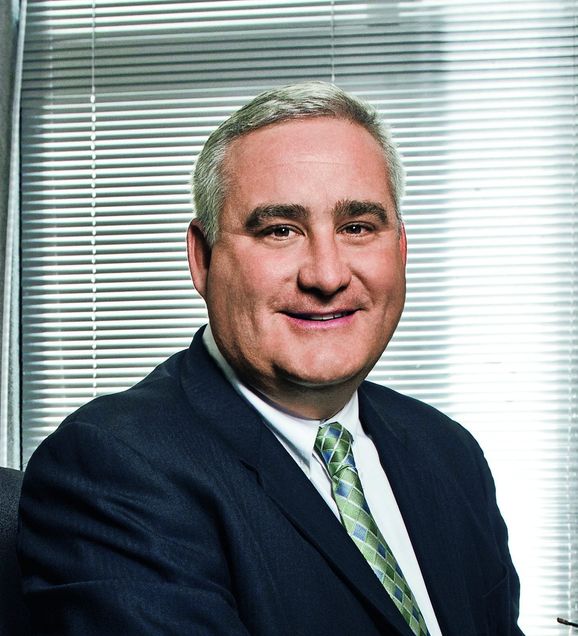 Sean J. Kealy is a clinical associate professor of law at Boston University School of Law where he directs the legislative clinical programs. Sean helped organize the APKN LawClinics and is an associate member of CALC
Sean J. Kealy is a clinical associate professor of law at Boston University School of Law where he directs the legislative clinical programs. Sean helped organize the APKN LawClinics and is an associate member of CALC
Some Unsolicited Advice To Nancy Pelosi (and Those Who Would Replace Her)
If the “Blue Wave” materializes next week, as so many predict, you Madame Leader, will become Speaker of the House once again. Time marches on, and as many have already pointed out, you and the rest of the top Democratic House leaders are all closing in on 80 years old. This situation was made even worse by the loss of Democratic Caucus Chair Rep. Joseph Crowley (D-NY); a relatively young 55 years old, to a primary challenge. There is already a movement by younger members of the Democratic Caucus for a change in leadership, but you and the other leaders do not seem to be going anywhere. It is time, however, for you—and the rest of Congress— to take a hard look at how the House is run. I would argue that when Congress worked—during the second half of the 20th Century— younger potential leaders were groomed for the difficult office of Speaker. It is time to return to that practice.
The House of Representatives was most effective during the so-called “Austin-Boston Connection” that dominated the House for 55 years; from 1940 until 1995. During nearly all of this time—from the Depression until Bill Clinton’s “bridge to the 21st Century,” the Democrats held a majority in the House. The House consistently passed needed legislation, effectively used its oversight powers and worked with presidents of both parties; not because of sheer numbers or ideological purity—far from it. Rather, the House worked, in large part, because leadership routinely identified and trained future majority leaders and speakers. After years of apprenticeship, new speakers understood both how to use the levers of power and how to deal with the opposing party.
When the great Sam Rayburn first became speaker in 1940, he had not only been the majority leader for nearly four years, he had been the speaker of the Texas House for two years—starting at the age of 29. When he re-took the speakership for the last time in 1955, he had over 10 years previous experience as speaker and 4 more years as minority leader. When John McCormack became speaker (1962-1971), he had been the Majority Leader for 18 years.
Carl Albert (1971-1977) was majority whip for seven years and majority leader for nine years before taking the gavel. Tip O’Neill came to Congress after serving four years as the Massachusetts House Speaker, then served two years as majority whip and four more years as majority leader. O’Neill’s 10 year speakership (1977-1987) became the example for a House that ideologically opposed— but worked with—a president of the same, and then another, party. Jim Wright was majority leader for 10 years before his two year speakership (1987-1989) When Tom Foley (1989-1995) became speaker, he had been majority whip for six years and majority leader for two and a half years. Every one of these speakers came to office trained not just how to lead their own caucus, but how to reach across the aisle and create the majorities needed to pass complicated and controversial legislation.
Compare that to the level of preparation for leadership since then. Newt Gingrich (1995-1999) had only five years of experience as minority whip. Dennis Hastert (1999-2007) was relatively well-trained with four years as majority whip. You, Madame Leader, (2007-2011) were minority whip for only one year. John Boehner (2011-2015) was majority leader for one year, minority leader for four years and a committee chairman for five years. Paul Ryan (2015-2019) was just a committee chairman for five years before being drafted to be speaker.
From 1995 until now—half of the time the Austin-Boston era, we have had five speakers who had a combined five years of prior experience running the House as either the majority whip or leader. How did we get here? Frankly, the Democratic leadership has stagnated and grown old. The Republicans seem to prefer whoever will apply the Hastert Rule, to the exclusion of working with Democrats, giving outsized influence to a fringe caucus.
And what have we had since 1995? Gridlock, government shutdowns, speakers held hostage by small minorities within their own caucus. The difference in productivity is stunning. From 1973-2015, nine of the ten most productive Congresses were led by Albert, O’Neill, Wright, and Foley. The lone post Austin-Boston speaker is Hastert at #10 from 1999-2001. The least productive Congresses during that time were the two led by Boehner—2011-2015.
Some would blame this dysfunction on the rise of the Tea Party and the Freedom Caucus. Still, talented speakers have overcome even greater challenges: Speaker McCormack passed maybe the most significant law of the 20th Century, the Civil Rights Act of 1964 with 91 members of his caucus dead set against the bill. Now, when a few dozen members of the Freedom Caucus opposes a bill, it becomes impossible to pass. Others may say the problem is gerrymandering—but that has been a problem since the founding generation; and since the Supreme Court keeps avoiding the issue, it is not going away soon.
What does this history lesson have to say about the next Congress? This year it has become fashionable to run for Congress as a Democrat while running against you Rep. Pelosi by name. Gil Cisneros, who has received $2 million from the Democratic Party to run for the House, said he won’t be voting for you because, “new leadership is needed.” Tim Ryan (D-OH) got 63 votes in the last leadership vote and Rep. Seth Moulton (D-MA) has been openly critical of the current leadership. Rep. Linda Sanchez (D-CA) has also announced her candidacy for leadership. Perhaps this is good politics, but a new set of leaders with no experience is not in the best interest of either the Democratic Party or the House as an institution. None of these insurgents know what they are in for. If the House is to work—especially while dealing with the mess that is the Trump Administration— it needs a steady and experienced leader in charge.
To your credit, you have remained supportive of breakaway Democrats, “I’m OK. Just win baby. I think many of them are saying we need…new leadership, yeah I don’t take offense at that.” That is the right point of view for a House leader— and the Democrats are lucky to have a leader with four years of experience as speaker.
Still, you must look to the future now. Who will lead the House Democrats next? Are you training the next generation of leaders? Will they be practical, unifying politicians in the mold of the Austin-Boston era? I hear you plan to put a younger member in charge of the Caucus--and that is not enough. In the next session, you must entrust a new generation with the majority leader and whip positions and there are some terrific options:
Rep. Jim McGovern (D-MA) has mastered one of the most important levers of House power as ranking member of the Rules Committee. Rep. Diana DeGette (D-CO) immerses herself in complicated issues like stem cell research and gun control, and is already a deputy whip. Rep. Terri Sewell (D-AL) is another deputy whip with experience on the Intelligence Committee. Rep. Jim Himes (D-CT) is chair of the moderate New Democrats Coalition, a position Joe Crowley held before joining leadership. Any two of the four would bring new blood to leadership and be a bridge to the younger members.
If the House is to work again, we need you to train a new generation of leaders. It is time to bring back the leadership apprenticeships that worked so well during the productive Austin-Boston Connection.
 Sean J. Kealy is a Clinical Associate Professor of Law and the Director of Legislative Clinical Programs at Boston University School of Law.
Sean J. Kealy is a Clinical Associate Professor of Law and the Director of Legislative Clinical Programs at Boston University School of Law.
Can Partisan Gerrymandering be Stopped?
Attention to partisan gerrymandering has heightened as the next wave of redistricting fast approaches and the Supreme Court’s 2017-2018 docket included two cases regarding the constitutionality of partisan gerrymander. Following the release of the 2020 census, states will set out to redraw their district maps. States redistrict at least every ten years. The 2010 redistricting results are described as the most extreme partisan gerrymandering in our country’s history. The 2010 maps have a heavy Republican partisan advantage, as evidenced by the 2012 election results with Republicans gaining a 234 to 201 seat advantage in the House of Representatives despite Democrats winning 1.5 million more votes than Republicans. The Republican partisan advantage has remained strong. The Brennan Center for Justice has predicted that in the 2018 midterm elections Democrats will need to win by a margin of nearly 11 points to gain a majority in the House of Representatives. Democrats, however, have not won by a margin this large since 1974. Following years of heavily gerrymandered districts, a supermajority of Americans have indicated support for the Supreme Court to bring an end to partisan gerrymandering, yet the Court failed to take action this year.
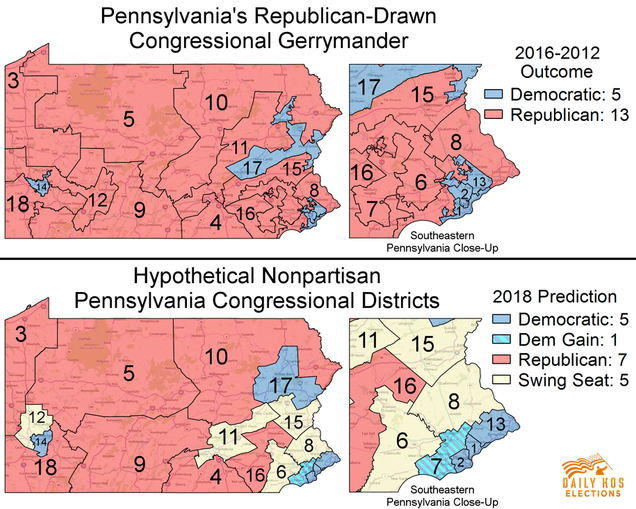 Partisan gerrymandering is the carving of districts, into sometimes odd shapes, to benefit a political party’s electoral prospects. The term gerrymandering was coined after Elbridge Gerry, a Massachusetts’s governor, in order to describe an irregularly shaped district that looked like a salamander in an 1812 redistricting map he signed into law. As a result, partisan gerrymandering has been a defining feature of “American politics since the early days of the Republic.” While racial gerrymandering is unconstitutional, the constitutionality of partisan gerrymandering is an open question, as the Supreme Court has never struck down a map for partisan gerrymander.
Partisan gerrymandering is the carving of districts, into sometimes odd shapes, to benefit a political party’s electoral prospects. The term gerrymandering was coined after Elbridge Gerry, a Massachusetts’s governor, in order to describe an irregularly shaped district that looked like a salamander in an 1812 redistricting map he signed into law. As a result, partisan gerrymandering has been a defining feature of “American politics since the early days of the Republic.” While racial gerrymandering is unconstitutional, the constitutionality of partisan gerrymandering is an open question, as the Supreme Court has never struck down a map for partisan gerrymander.
Partisan gerrymandering seems to fly in the face of democracy. Voting is a fundamental right and electing who you want to represent you in office is a fundamental part of democracy. Legislatures that scheme, plan, and manipulate maps to benefit one party over another can undermine the purpose of democracy. Some of this scheming, planning, and manipulating is self-interested as legislatures try to protect incumbents and create safe districts, but can also serve the purpose of entrenching a political party’s majority until the next redistricting cycle. Both parties, Republicans and Democrats, have enjoyed the benefit of partisan gerrymandering when given the opportunity.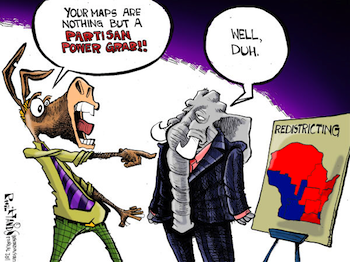
While the Supreme Court has indicated that some level of partisan gerrymandering may be unconstitutional, it has yet to explain when the constitutional line has been crossed. This term, the Supreme Court took up the question of partisan gerrymandering for the first time in more than a decade. The two cases before the Supreme Court were Gill v. Whitford and Benisek v. Lamone. The Supreme Court was asked to answer when partisan gerrymander crosses the constitutional line. Gill v. Whitford challenged a statewide map that has been deemed among one of the worst partisan gerrymandered maps in the country, with a significant Republican partisan advantage. Benisek v. Lamone challenged one congressional district in Maryland, with a significant Democratic partisan advantage. Some speculated that the Court took up both cases to deter an appearance that the Supreme Court prefers one party over the other. Another reason may be that the Wisconsin case was a challenge to a statewide map compared to the Maryland case challenging one congressional district.
The appellants attorney in Gill v. Whitford argued during oral arguments (see, page 62) that the Supreme Court is the only institution to put an end to partisan gerrymandering. The Court, however, sidestepped the entire issue by unanimously finding the Gill plaintiffs did not have standing, and that the challengers in Benisek had waited too long to seek an injunction blocking the district. The Supreme Court’s silence allows legislatures to continue to strategically gerrymander.
While the country waits on the Supreme Court to provide an answer on the constitutionality of partisan gerrymander, some states have attempted to take partisanship out of the process by using redistricting commissions, while others suggest that computers with algorithms should produce the maps. Yet, neither of these options individually seem to completely insulate redistricting from politics.
States have adopted redistricting commissions with the intention to remove partisanship from the redistricting process. However, this has often proved difficult to achieve, as finding non-partisan committee members is difficult and oftentimes the commission is appointed by partisan members, such as elected representatives and governors. States use different types of commissions and may only use a commission for redistricting the state map or congressional map. About 23 states use commissions for the state legislative maps and about 14 states use commissions for the congressional maps. The redistricting commissions can take the form of an advisory commission that makes suggestions to the legislature, a backup commission that draws the map if the legislature fails to redistrict, or as having the primary responsibility of drawing the map.
Even states that use independent redistricting commissions have had difficulties completely insulating the process from politics. For instance, in 2011, Arizona’s Independent Redistricting Commission chairwoman was removed by the Republican Governor and the Republican-controlled State Senate. The Governor accused the chairwoman of skewing the process for Democrats. The Arizona Supreme Court, however, reinstated the chairwoman and the United States Supreme Court upheld Arizona’s independent redistricting commission as a legitimate way to draw district maps. Although some states are moving toward redistricting commissions as a way to insulate the process from politics, these commissions are “only as independent as those who appoint it.”
While technological advances have been thought to help parties gerrymander more effectively, some suggest that similar technology could take politics out of the process with the proper algorithms. Brian Olson, a Massachusetts software engineer, wrote an algorithm to create “‘optimally compact’ equal-population congressional districts.” Olson prioritized the compactness requirement in an effort to reflect “actual neighborhoods” and because dramatically non-compact districts can be a “telltale sign of gerrymandering.” However, political scientists are skeptical about an algorithm prioritizing compactness, because it ignores other important factors, such as community of interest. Furthermore, someone needs to set the algorithm and there can be infinite map results. Thus, without very strict restrictions and guidelines, setting an algorithm and picking the map can still be an inherent gerrymander.
Removing politics completely from the redistricting process appears to be nearly impossible. Partisanship is deeply entrenched in the process, and dates back to even before the coined term “gerrymander.” Redistricting commissions do not always guarantee a partisan free redistricting effort, and while technology offers an alternative to human map drawing, humans are still making the final decision. Some combination of these efforts may help to lessen the amount of politics used in the redistricting process or lessen the appearance of partisanship, but are unlikely to completely end partisan gerrymandering all together.
 Mikayla Foster anticipates graduating from Boston University School of Law in May, 2019.
Mikayla Foster anticipates graduating from Boston University School of Law in May, 2019.
A Practical Guide to Surviving Your First Legislative Externship
I have done quite a few externships over the years in a variety of fields. However, working at the State House has kept me on my toes. I had so much to learn. I had a great boss and that helped. But looking back, I wish I had prepared a little better. I had no legislative experience and was not from a state that did a lot of state government work. So here are a few tips I would give to those who are new to this environment.
- Learn a little about your state!
When I started my externship, I did not know anything about Massachusetts. I mainly came here to go to school and that was it. However, since working at the State House, I wish I knew more about the state and my senator’s district. I spent a lot of time googling regions of Massachusetts and asking questions. So if you have a legislative externship, feel free to do your research. Learn about the state and who are the constituents. Does a state have a larger rural population or an urban population? What are the industries and demographics of a state? Knowing these things will enhance your experience and give context to your interactions at the state house.
- Understand that state government is different from federal government
Being from Washington, DC, I had no concept of how state government worked. In my area, everything is concentrated in either the federal government or the local government. I had always viewed the federal government as a constant stalemate or arguing about things that did not matter. I thought that senators were inaccessible and expected that from my externship. However, I was wrong. Senators in Massachusetts are generally pretty accessible and enjoy hearing from their constituents. I had no idea that a state senator would be different from a US senator. But while working for a state senator, I felt as though I was actually contributing to tangible changes. This is a super rewarding feeling that you won’t get anywhere else.
- Get familiar with the State House Website and State House News.
I believe this is one of the most important lessons I learned while working at the State House this year. The fastest way to learn about the State House is to read State House News and the State House website. Boston University School of Law provides its students with a free subscription to State House News. If you want to find out anything about what’s happening in the state house, State House News is the place to look. They have information on bills, legislators, and general news. The State House website will hold all of the bill before the legislature and the general laws. I spend most of my time on that website. Feel free to check out the site before you start your externship. That way you are ready to hit the ground running.
- Never miss a meeting.
Some people hate meetings, but at your legislative externship you will learn to like them. One, they are much more fun than normal meetings at the office. Second, they are actually useful. Most of your meetings with either be with lobbyists or constituents. Making sure you are present for these meetings will teach you a lot about your senator’s district and their priorities. This was the forum where I learned the most. So, make sure you are there!
- Be open to saying I don’t know.
This is probably self-explanatory, but just be honest if you don’t know something. Your supervisor knows that this is an externship and that you are here to learn. Be honest about your experience level and don’t be afraid to ask questions. This externship is designed for you to learn so take advantage of it.
Externships are a serious investment of time and your tuition dollars. The Massachusetts State House can be an awesome place to work and to learn. Learn a lot, enjoy the experience, and make the most of it!
 Nia Johnson anticipates graduating from Boston University School of Law in May 2019.
Nia Johnson anticipates graduating from Boston University School of Law in May 2019.
Failure Modes and Effects Analysis in the Legislative Process
In my last post, I argued that the process of drafting new legislation should be undertaken with a problem-solving mindset. I suggested that problem-solving tools from a variety of disciplines could be advantageously adapted to the legislative process. In this post, I will present the manner in which one specific tool—Failure Modes and Effects Analysis (FMEA)—could be used in legislative drafting.
FMEA was originally developed as a tool to improve processes within the manufacturing industry. An FMEA is a “systemic method of identifying product and process problems before they occur.” Robin E. McDermott, Raymond J. Mikulak, Michael R. Beauregard, The Basics of FMEA 3 (1996). (Many of the details of the FMEA process discussed in this post come from The Basics of FMEA. I highly recommend that anyone interested in performing FMEAs in the legislative process read this book. The steps of an FMEA can be found in the book or online, here.) In the manufacturing context, the goal of an FMEA is to figure out how a new product or process is likely to fail, before that failure happens, and then to recommend improvements that will preemptively prevent the failure. In FMEA terminology, the process is designed to identify and resolve “failure modes” in a product or process.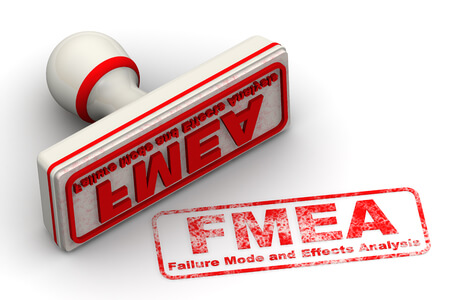
In the legislative context, a bill working its way through the legislature can be thought of as the new “product or process” to which an FMEA can be applied. In this post, I will discuss where in the legislative process an FMEA could be performed, what the make-up of an FMEA team might be, and what beneficial output could be expected from an FMEA.
The authors of The Basics of FMEA, recommend that “[i]deally, FMEAs are conducted in the product design or process development stages, although conducting an FMEA on existing products and processes may also yield huge benefits.” The Basics of FMEA at 3. Likewise, a legislature could use FMEAs to analyze already existing laws. However, in this post, I will only describe FMEAs that would take place during the drafting process. Such an FMEA would likely be most useful to the legislative process after a committee performs hearings and before it votes on a bill. At this point, the committee has already gathered a wealth of useful information and the legislature still has wide latitude to make changes to the bill when potential failure modes are discovered.
The FMEA team itself should consist of four to six members. Id. at 15. Idealistically, the team will “bring a variety of perspectives and experiences to the project.” Id. This will likely result in team members having varying degrees of expertise in the relevant subject matter and a range of familiarity with the legislation being reviewed. For example, an FMEA team for a bill related to criminal justice might include: a legislative attorney familiar with the bill, a representative from the police force, an associate district attorney, a public defender, and representatives from advocacy groups or lobbyists. It is worth noting that many of the individuals on the team may be the same individuals who provided testimony in a committee hearing. Such overlap does not diminish the unique value that can be obtained by an FMEA. Likewise, an FMEA would in no way detract from the value of the committee hearing. Committee hearings give advocates an opportunity to state their case and respond to questions from members of the committee. The FMEA would give these individuals an opportunity to interact with one another and to work towards improving legislation in ways in which they can all agree.
It is also important to note that many of the FMEA team members may also represent the individuals that the law is meant to address—the “role occupants” and implementing agencies. See Ann Seidman & Robert B. Seidman, Instrumentalism 2.0: Legislative Drafting for Democratic Social Change, 5 Legisprudence 95, 95 (2011). The Seidmans note that a role occupant’s failure “to respond to a law’s commands, prohibitions or permissions, signifies . . .
that, in drafting the bill’s detailed prescriptions, the drafter failed adequately to take into account the relevant constraints and resources in the role occupant’s environment.” Id. at 136. Bringing representatives of role occupants and implementing agencies into the legislative process via FMEAs would help to reduce these drafting failures.
Of course, the ultimate language of a bill must be determined by legislators and legislative attorneys. Nevertheless, the recommendations of an FMEA team regarding specific bill language could be of significant help to those tasked with the actual drafting of the bill. An appropriate balance of power between drafters and the FMEA team can be established by providing FMEA teams with “clearly defined boundaries within which they are free to conduct the FMEA and suggest and implement solutions.” The Basics of FMEA at 20-23. For example, the scope of a drafting-focused FMEA could be limited to the language of the bill, excluding considerations of the substantive legislative plan embodied in the bill. While a broad legislative scheme may be well suited to effectuate desired change, the language of a bill may fail to adequately implement the legislative plan. Such an FMEA could identify, document, and recommend corrections to any problematic drafting discovered. Once the bill is revised, the FMEA team could re-convene and repeat its analysis.
Whenever a new step is added to a process, a fear may arise that the process is becoming more complex, and therefore less efficient. The inclusion of FMEAs in the process of drafting legislation would undoubtedly require legislative drafters to overcome a steep learning curve. Once that learning curve is overcome, however, use of the FMEA methodology will yield significant benefits. In the short term, the FMEA could uncover and correct potential problems in a bill before it leaves its committee. In the long term, effective FMEAs would decrease the likelihood that laws would need to be revised to address problems that were not foreseen during the drafting process. Idealistically, the end result will be a more efficient legislative drafting process resulting in the passing of better drafted laws.
 Andrew P. McDonough graduated from Boston University School of Law in May 2018.
Andrew P. McDonough graduated from Boston University School of Law in May 2018.
Ballot Initiatives as a Fourth Branch of Government?
The Massachusetts Marijuana Legalization Initiative was a consistent conclusion to the State’s foray into cannabis regulation. Massachusetts decriminalized and legalized cannabis for medical use through ballot initiatives in 2008 and 2012, preparing the public for a controversial and protracted path towards legalization. The success of Question Four raised a multitude of familiar policy questions; what are the legal risks legalizing a federally prohibited substance, or how to entice investor confidence in a cannabis market given the Trump Administration’s regressive cannabis policy? There is also a more democratically existential question: what is the role of the voter initiative, and should this role be celebrated?
The Commonwealth of Massachusetts provides for such direct participation through four ballot initiative forms: law petitions, constitutional amendment petitions, referendum petitions, and public policy petitions. Law petitions, the mechanism most widely understood through the public, are governed by surprisingly straightforward rules. Ballot petitions begin their lives as petitions of law to be adopted by the Legislature. Massachusetts first requires a minimum of ten qualified voters to draft and sign a petition containing the full text of the proposed law for submission to the Attorney General, who returns the petition with a concise summary following confirmation that the subject of the proposal has not violated any Constitutional or procedural requirements. Petitioners then file the proposed law and summary with the Secretary of the Commonwealth, who in return provides signatory forms containing the law’s summary for the gathering of signatures. Assuming that this summary and petition form are returned without challenge, an achievement it its own right, petitioners may then move to acquire the requisite signatures, quantified as “at least . . . 3% of the total vote cast for all candidates for Governor (excluding blanks) at the last state election.”
any Constitutional or procedural requirements. Petitioners then file the proposed law and summary with the Secretary of the Commonwealth, who in return provides signatory forms containing the law’s summary for the gathering of signatures. Assuming that this summary and petition form are returned without challenge, an achievement it its own right, petitioners may then move to acquire the requisite signatures, quantified as “at least . . . 3% of the total vote cast for all candidates for Governor (excluding blanks) at the last state election.”
The ballot initiative process is not designed to circumvent the legislature – at this stage, the legislature considers the petition, without opportunity for amendment, and may ultimately vote for engrossment and delivery to the Governor for final signature. Even at this stage, the democratic power of ballot initiatives is compelling, regardless of whether enactment follows. The legislature may feel increased pressure to address the subject through independent legislation, responding to a newly recognized mandate from the public will, while avoiding the drafting and policy deficiencies sometimes associated ballot initiatives. These responses are not direct responses to the initiative petitions, however. The legislature may only take four actions: enactment, disapproval, inaction, or proposal of a substitute. Any action beside enactment returns the initiative to its petitioners, who upon gathering the requisite number of signatures, puts the question to the voters at the next state-wide election.
Democracy in Action, or a Breakdown in Lawmaking?
The utility of ballot initiatives is more than the results they may yield. Substantive results aside, the evaluation of ballot initiatives is multifaceted. First, ballot initiatives provide an opportunity to spur reactionary legislation, by presenting to legislatures with a choice between engrossing the initiative law petition themselves, pursuing independent legislative action on the matter, or rejecting the measure and resigning its fate to the public’s will.
Second, ballot initiatives provide a path for citizens to democratically express their ideas. Of course, the democratic nature of ballot initiatives says nothing of morality: initiatives range from the laudable measures calling for statewide universal healthcare to the morally insolvent represented by acts like the “Sodomite Suppression Act”, a reprehensible initiative calling for statewide execution of members of the LGBTQ community.
The range of subjects covered by ballot initiatives is nearly limitless, and while most initiatives do not survive long enough to receive a vote from the general public, ballot initiatives remain procedurally significant merely in that they are introduced into the marketplace of ideas. This procedural significance exists regardless of the substantive merits of the initiatives, with democratically compelling state ballot initiative questions like: “should we give $1 million to one random voter?”, “should Denver set up a commission to track aliens?”, and “should we stop selling the Europeans our horse meat?” Regardless of the content of the initiatives, their consideration is itself a democratic virtue and strong argument for the continued use of ballot initiatives.
Third, while ballot initiatives are democratic,they sometimes produce substantively imperfect results. Despite being the will of the people, the substantive terms of the Massachusetts Marijuana Legalization Initiative were short-lived. Towards the end of July 2017, Massachusetts Governor Baker signed into law House No. 3818, An Act to ensure safe access to marijuana. This law amended the voter approved cannabis laws by raising taxes on cannabis from 12% to 20%, altered the scheme in which municipalities could ban legal cannabis sales, and restructured the newly formed Cannabis Control Commission. As a result, although legalization advocates were able to achieve their goal of legalizing cannabis, the regulatory structure was significantly different than originally envisioned.
Ballot Initiatives: The People’s Branch of Government – Truism, or Absurdity?
The debate over the place of ballot initiatives within democracy is ongoing. On one hand, ballot initiatives can be construed as a “fourth branch of government” (or perhaps fifth, for those readers who may also delegate such status to administrative agencies).
 Ballot initiatives allow citizens to circumvent special interests and legislative roadblocks to see their will materialized. Alternatively, although ballot initiatives support the free expression of ideas, they fail to provide an opportunity for consideration and compromise with dissenting views, which is substantially undemocratic. Rather than circumventing special interests, this shortcoming may make ballot initiatives the epitome of special interests, allowing the loudest voices in the room to acquire funding and support on the public sphere, regardless of their relative merits and detractors.
Ballot initiatives allow citizens to circumvent special interests and legislative roadblocks to see their will materialized. Alternatively, although ballot initiatives support the free expression of ideas, they fail to provide an opportunity for consideration and compromise with dissenting views, which is substantially undemocratic. Rather than circumventing special interests, this shortcoming may make ballot initiatives the epitome of special interests, allowing the loudest voices in the room to acquire funding and support on the public sphere, regardless of their relative merits and detractors.
The cannabis ballot initiative saga in Massachusetts presents a compromise between this dichotomy. Ballot initiative lawmaking may indeed represent a new “fourth branch of government” – but a fourth branch that is weaker in its power. As Massachusetts has shown, voter approved laws remain subject to the check and balance of subsequent legislative action, which in turn is checked by traditional balance of powers built into state and federal constitutions. The ballot initiative process has a demonstrable capacity to force legislative action, a democratic strength in its own right.
 Connor Mullen anticipates graduating from Boston University School of Law in May 2018.
Connor Mullen anticipates graduating from Boston University School of Law in May 2018.
The Problem-Solving Legislature
Someone once told me that the large windows of the Massachusetts State House symbolize openness. They allow the public to see what their legislators are doing inside. The law-making that happens within is complex, as seen here, or here. In this post, I propose that legislatures should approach the complex law-making process as a problem-solving enterprise. Rather than simply trying to label the legislative process, I suggest that a problem-solving mindset—employing problem-solving tools and methodologies—applied to the development of every bill would result in better legislation.
Former Boston University Law Professors Ann and Robert Seidman, also conceived of law making in problem-solving terms. See, e.g., Ann Seidman & Robert B. Seidman, Instrumentalism 2.0: Legislative Drafting for Democratic Social Change, 5 Legisprudence 95 (2011). The Seidmans developed a “four-step, problem-solving methodology . . . [for] designing legislation aimed at ameliorating perceived social problems” Id. at 100. The eight-step methodology that I propose below bears some similarities and some differences to that of the Seidmans. The most significant difference between the two theories is focus. The Seidmans’ methodology is focused on how a drafter can craft a piece of legislation oriented around the behaviors of relevant actors, thereby achieving desired social change. See id. at 133-140. My methodology is focusesd more on the substantive solution a legislature decides to implement, and less on the drafting of that solution into a bill. They focus on the legislative drafter. I focus on the legislative process.
To this end, I have formulated the following outline of an effective problem-solving process. These steps were inspired, in part, by the scientific method, and the Eight Discipline Problem Solving process developed by the Ford Motor Company to resolve problems in a manufacturing environment. My eight steps are:
- State the problem or goal.
- Understand the problem (gather and analyze relevant data).
- Propose, discuss, and refine prospective solutions.
- Critically assess those solutions (Considering things such as costs, value, risks, and likelihood of success).
- Select and implement the most advantageous solution.
- Measure the results of the implemented solution.
- Communicate success.
- Identify the next problem or goal to address.
These steps could be used to develop a legislative solution in the following manner:
- State the problem or goal.
Problem statements in the early stages may be broad, and refined, as the process proceeds, into a more specific goal.
- Understand the problem (gather and analyze relevant data).
This step would likely be completed by a legislative committee. It is important for the committee to do more than reach out to experts, interest groups, and lobbyists for opinions and selective data. The committee must identify the relevant data that it needs to understand the problem, gather that data, and critically analyze it—which may require consulting experts in statistical analysis.
- Propose, discuss, and refine prospective solutions.
With a deep understanding of the problem, the committee should generate a wide range of solutions. Creativity is particularly valuable at this stage.
- Critically assess those solutions.
The legislature should assess the potential solutions using cost-benefit analyses, addressing constitutional limitations, and analyzing questions of political viability.
- Select and implement the most advantageous solution.
At this step, the Legislature must weigh two broad categories of considerations: (1) The results of the critical assessments completed in Step 4; and (2) The critical assessments performed by other problem solvers (other committees) working to solve other problems. Budgetary constraints may not support the most ambitious solution to every problem a legislature tackles. Accordingly, the solutions selected should be the best array of solutions possible within budgetary restraints.
- Measure the results of the implemented solution.
Designing a prospective solution requires identifying how to measure the success of that solution. This requires a method to monitor the solution after implementation.
- Communicate success [or failure].
Representative democracy benefits from an informed citizenry. Communicating the results of legislation ensures that citizens are aware of, and understand, what their government is doing and what needs to be done. Further, communicating legislative success can have a benefit within the legislature itself, by making other legislators aware of solutions that have worked to solve other problems.
- Identify the next problem or goal to address.
Measuring and reporting the effects of new legislation informs legislators and the public, giving new insight and revealing other, related problems. These newly identified problems require the legislature to return to Step 1.
Some might argue that what I have just described is what Legislatures actually do. They identify problems, gather information, and craft bills in light of what they have learned. The difference is in the details. It seems to me that the substance of much of the legislation that gets drafted is inspired by political ideology, perceived constitutional concerns, and political deal making. Each of these considerations likely belong in the legislative process. They should not, however, limit the range of solutions that legislatures consider. Rather, legislatures should seek to consider as broad a range of potential solutions as possible. Those solutions should be inspired by rigorous research, not politics. When political or constitutional considerations drive a legislature to select one solution over another, it should be clear what solutions they are passing over in favor of the ideological or politically expedient choice.
One way to effectuate this goal is to take advantage of problem-solving methodologies from a wide range of disciplines when attempting to solve problems (draft legislation). The Seidmans’ suggestion that drafters should consider the behaviors of various individuals has a place in this methodology. Their process is not, however, the only tool that can, or should, be applied to legislative problems. In a future post, I will present a problem-solving tool from the world of manufacturing that could be usefully inserted into the legislative process as part of instituting a problem-solving mindset.
I conclude by asking what expectations we should have for legislators in a representative democracy. I submit that we should expect them to make informed decisions. We should expect them to base solutions to problems on rigorously collected and analyzed information, and to enshrine those solutions into law. The problem-solving mindset that I advocate for would help to achieve this goal.
 Andrew P. McDonough anticipates graduating from Boston University School of Law in May 2018.
Andrew P. McDonough anticipates graduating from Boston University School of Law in May 2018.
Legislator of the Year– Senator John McCain
John McCain has served in the United States Senate for nearly 31 years, and is probably due a lifetime achievement award. This award, however, is not for his distinguished service in the US Navy, nor for his many accomplishments over three decades in Congress, nor for the honorable manner in which he ran for and lost the Presidency. Springsteen and U2 don't win lifetime achievement awards because they keep turning out relevant hits and earning new generations of fans. Likewise, Sen. McCain wins this year's award for his ringing call over the summer for Congress to return to regular order, backed up by his courageous break with his party during the Affordable Care Act repeal vote.
In late July, Sen. McCain returned to the the Senate to cast a critical vote to proceed to debate on the Senate's Obamacare repeal legislation. Sen. McCain, who had just disclosed that he was diagnosed with an aggressive form of brain cancer, then offered a passionate plea to his fellow senators:
"I've known and admired men and women in the Senate who played much more than a small role in our history, true statesmen, giants of American politics. They came from both parties, and from various backgrounds. Their ambitions were frequently in conflict. They held different views on the issues of the day. And they often had very serious disagreements about how best to serve the national interest.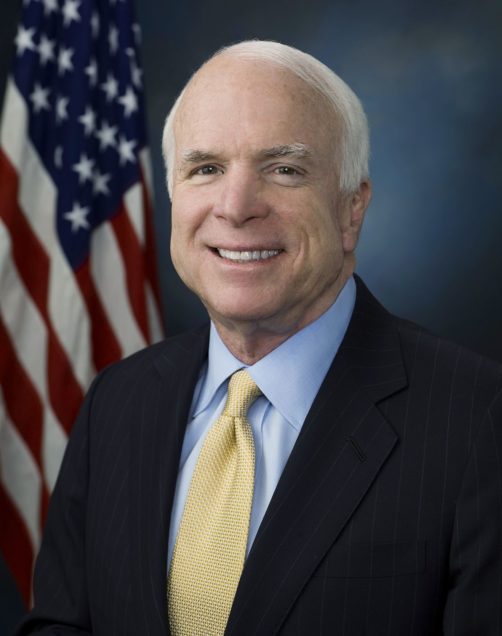
"But they knew that however sharp and heartfelt their disputes, however keen their ambitions, they had an obligation to work collaboratively to ensure the Senate discharged its constitutional responsibilities effectively. Our responsibilities are important, vitally important, to the continued success of our Republic. And our arcane rules and customs are deliberately intended to require broad cooperation to function well at all. The most revered members of this institution accepted the necessity of compromise in order to make incremental progress on solving America's problems and to defend her from her adversaries.
"That principled mindset, and the service of our predecessors who possessed it, come to mind when I hear the Senate referred to as the world's greatest deliberative body. I'm not sure we can claim that distinction with a straight face today.
"I'm sure it wasn't always deserved in previous eras either. But I'm sure there have been times when it was, and I was privileged to witness some of those occasions.
"Our deliberations today -- not just our debates, but the exercise of all our responsibilities -- authorizing government policies, appropriating the funds to implement them, exercising our advice and consent role – are often lively and interesting. They can be sincere and principled. But they are more partisan, more tribal more of the time than any other time I remember. Our deliberations can still be important and useful, but I think we'd all agree they haven't been overburdened by greatness lately. And right now they aren't producing much for the American people.
"Both sides have let this happen. Let's leave the history of who shot first to the historians. I suspect they'll find we all conspired in our decline --either by deliberate actions or neglect. We've all played some role in it. Certainly I have. Sometimes, I've let my passion rule my reason. Sometimes, I made it harder to find common ground because of something harsh I said to a colleague. Sometimes, I wanted to win more for the sake of winning than to achieve a contested policy.
...
"Our system doesn't depend on our nobility. It accounts for our imperfections, and gives an order to our individual strivings that has helped make ours the most powerful and prosperous society on earth. It is our responsibility to preserve that, even when it requires us to do something less satisfying than 'winning.' Even when we must give a little to get a little. Even when our efforts manage just three yards and a cloud of dust, while critics on both sides denounce us for timidity, for our failure to 'triumph.'
"I hope we can again rely on humility, on our need to cooperate, on our dependence on each other to learn how to trust each other again and by so doing better serve the people who elected us. Stop listening to the bombastic loudmouths on the radio and television and the Internet. To hell with them. They don't want anything done for the public good. Our incapacity is their livelihood.
"Let's trust each other. Let's return to regular order. We've been spinning our wheels on too many important issues because we keep trying to find a way to win without help from across the aisle. That's an approach that's been employed by both sides, mandating legislation from the top down, without any support from the other side, with all the parliamentary maneuvers that requires.
...
"I voted for the motion to proceed to allow debate to continue and amendments to be offered. I will not vote for the bill as it is today. It's a shell of a bill right now. We all know that. I have changes urged by my state's governor that will have to be included to earn my support for final passage of any bill. I know many of you will have to see the bill changed substantially for you to support it.
...
"Why don't we try the old way of legislating in the Senate, the way our rules and customs encourage us to act. If this process ends in failure, which seem likely, then let's return to regular order.
"Let the Health, Education, Labor, and Pensions Committee under Chairman Alexander and Ranking Member Murray hold hearings, try to report a bill out of committee with contributions from both sides. Then bring it to the floor for amendment and debate, and see if we can pass something that will be imperfect, full of compromises, and not very pleasing to implacable partisans on either side, but that might provide workable solutions to problems Americans are struggling with today.
"What have we to lose by trying to work together to find those solutions? We're not getting much done apart. I don't think any of us feels very proud of our incapacity. Merely preventing your political opponents from doing what they want isn't the most inspiring work. There's greater satisfaction in respecting our differences, but not letting them prevent agreements that don't require abandonment of core principles, agreements made in good faith that help improve lives and protect the American people.
...
"The success of the Senate is important to the continued success of America. This country --this big, boisterous, brawling, intemperate, restless, striving, daring, beautiful, bountiful, brave, good and magnificent country -- needs us to help it thrive. That responsibility is more important than any of our personal interests or political affiliations."
A few days later, Sen. McCain carried out his promise to vote against a bill that he continued to see as an "incomplete shell." His vote doomed the effort to "repeal & replace" the Affordable Care Act.
Amazingly, after being elected to Congress as a Reagan Republican, and running as the GOP candidate for President, Sen. McCain now has a higher favorability among Democrats and independents than Republicans. In December 2017, a CCN poll showed 68% of Democrats and 48% of independents had a favorable opinion of the Senator, whereas only 46% of Republicans felt the same. In this toxic political time, some Republicans even whisper that Sen. McCain is a RINO, a "Republican In Name Only," especially after his health care vote in August. That is truly sad.
What is more conservative than demanding Congress, the branch that has the greatest capacity to do good or harm to the Republic, operate by its own time-honored traditions and rules and subject major bills to bi-partisan scrutiny and amendment before passage? Many Republicans railed against these practices when former Democratic Leader Harry Reid recklessly used the "nuclear option" to end most judicial filibusters, and routinely "filled the tree" to prevent consideration of Republican amendments. Yet once the GOP gained control of the Senate, they too placed ideology and winning over creating bipartisan agreement on important issues.
A strong functioning Congress is especially important now. President Trump is a small man—seemingly devoid of ideals or morals. He cares nothing for policy details, but just his own image and “winning†deals. His “leadership†has demoralized executive agency personnel and harmed the nation's image oversees. Senators should try to emulate the legends that went before them--Goldwater, Kennedy, Dirksen, Inouye, Ervin, Taft, Fulbright--and now McCain. The House leadership should be taking the example of Cannon, Rayburn, Martin and O'Neill-- and stop kowtowing to the so-called "Freedom Caucus." Congress needs to pull itself together to first balance, and then cure, Trumpism.
For his bold and timely call for a return to regular order, Dome is pleased to name Senator John McCain our Legislator of the Year.


